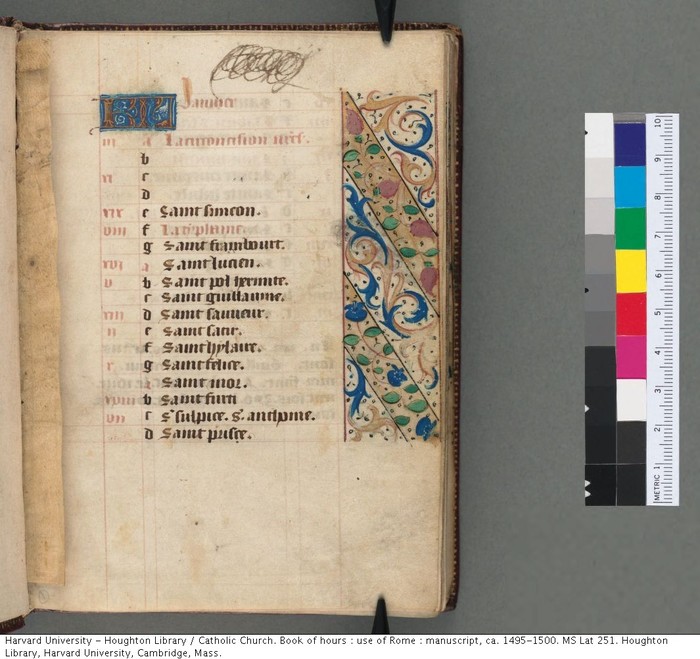This is the most recent addition of a large block that I have not yet discussed. I am hoping to catch up on delayed commentary soon
Latin 3780, from the Biblioteca Apostolica Vaticana, is a late 15th C book made in Lyon, Use of Rome. We know it was made for one of the Italian merchants based in that city. It was made either in 1478 or 1479, based on a Golden Number table on f.14v which starts with the indications for 1479.
The calendar is very sparse, with 115 entries in total. There are very few distinctive entries, though St Livinus, bishop 288, on November 12 is uncommon. There are several unusual orthographies, Aghate for Agathe, and Ad cathedra petri for the more common Cathedra sci petri. Apart from a few instances of miscounting, there appear to be almost no errors, and no instances of a saint being bumped by a higher-ranked feast.
(DB Id: 276)
Catching up on some backlogged additions to the database.
First is up is Bibliothèque nationale de France, Latin 1171. This Hours Henri IV is unusual for the golden parchment used throughout the manuscript, every page of text is a matte gold, perhaps shell gold. The miniatures are done in a semi-gresaille style, with touches of gold and purple, and brown wash.
The calendar is complete and has an interesting scribal trick to handle the color of the entries. The feasts alternate red and blank ink evenly, with high-importance feasts identified by a larger, white, capitol letter to start them. This solves for the desire to keep the perfectly regular color pattern without loosing the indication of important feasts, cf. DB Id 266. There is some ambiguity in the Vigils, which are indicated with a white paraf mark before the word. I am treating these as “high” importance, but the paraf could indicate a medium range. Since these only appear on the Vigils, and appear on all of those, there is little additional data to use.
The calendar entries are in French and there are a surprisingly large number of unidentified saints, including some with unique names, Saint Feulgent on March 18 as an example (see f.2r below)
(DB Id. 162)
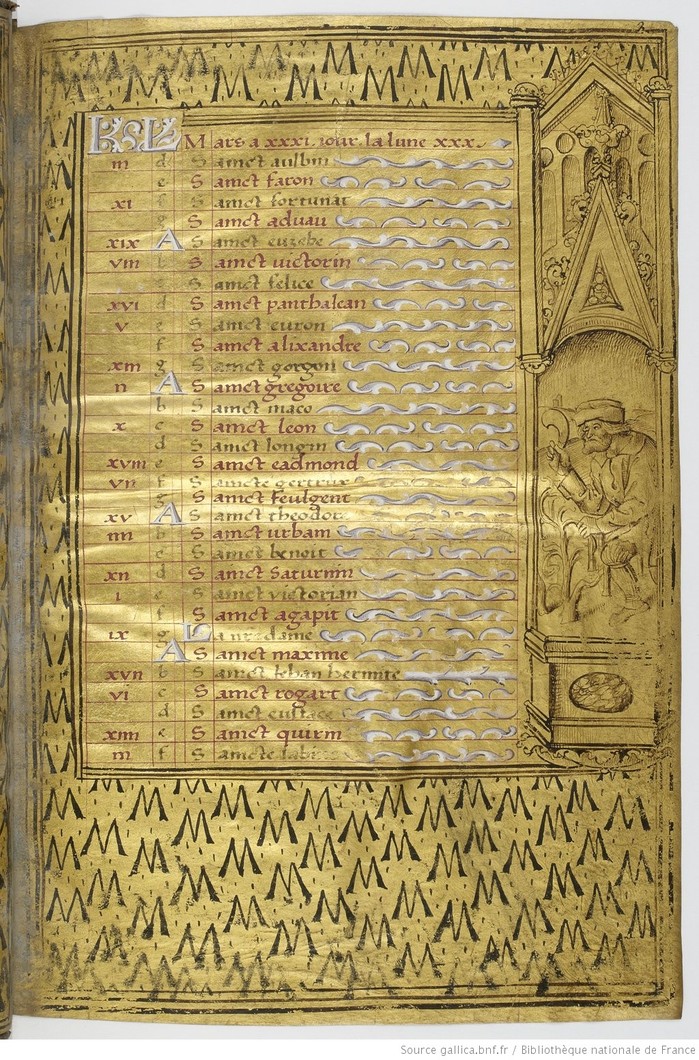
Taking a break from the e-codices stuff, the Vatican uploaded one of their Sanvito Books, Vat.lat.9490. This one is both Use of Rome and made in Rome, and entirely on purple vellum. The calendar is written in gold and silver, with silver for the high-importance feasts and gold for the regular. The calendar is exceptionally accurate, 2 saints are offset a single day and not a single one is unidentifiable, out of 205 entries. There is a decidedly Fransiscan slant to the saints, with the feast of his Stigmatization(3722) and the Translation of St. Clare(3359), both in silver, and the Octave of his Feast(3992) and the feast of Peter Martyr(273), both in gold. In an unusual bit of scribal whim, some few saints are written as "Saint Martyr Name", versus the more common "Saint Name Martyr", for example see Trifonis & Respici on November 10, below f.13r
(DB Id: 251)
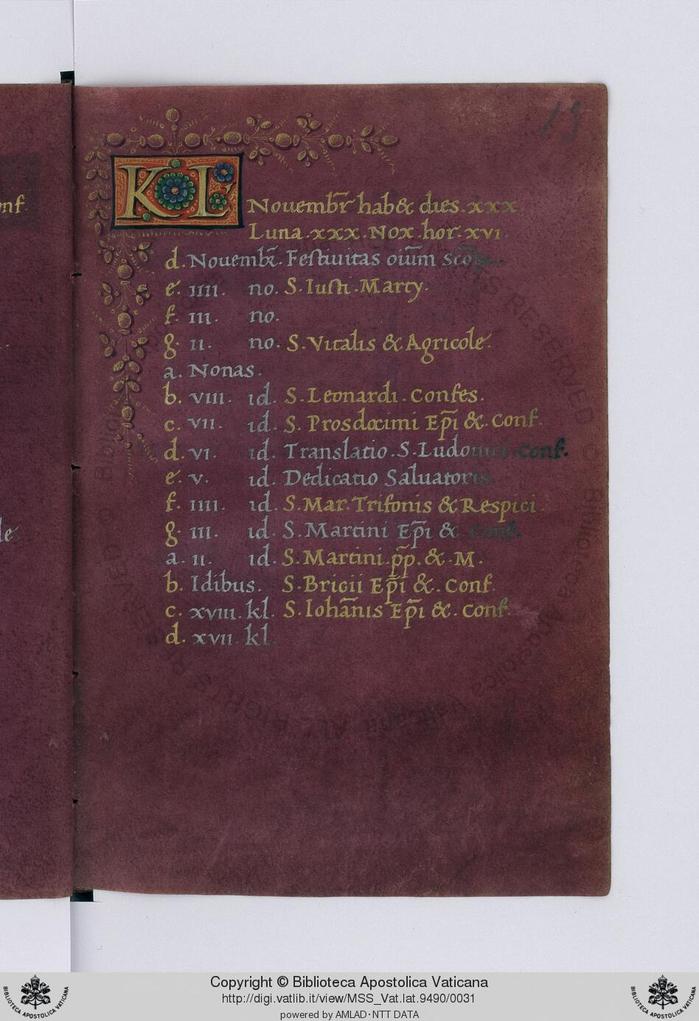
The other digitized hours from the Comites Latentes collection of the Bibliothèque de Genève, hosted by the excellent e-Codices site, was made in Tours for a customer from Toulouse, Comites Latentes 124. Two of the miniatures are by Jean Bourdichon, the rest by the workshop of the equally distinguished Jean Poyer.
The calendar is rather unusual on the page. The ruling is more complex than usual, with seven ruled columns, the main set off with double-lines. The saints are in black, with gold for the important and red for vigils, but most of the gold has flaked off. The Egyptian Verses and the name of the month are in silver, which has aged very well with little loss or oxidization. The entries are very accurate, with only 6 of 240 unknown and a few more unidentified. An unusual, actually unique so far, entry is the Vigil for Candlemass 4212.
(DB Id: 240)
After another 2 day visit to the Morgan Library, I am once again bulk-loading data. The first three books from this trip are:
- M.487 - An English MS from the 1490s, probably made for a small child as there are many more educational texts than usual. Saints are quite British, including David, Cedde, Richard and Cuthbert. Unusually St. Edward, King, on March 18 is in red. (DB Id: 233)
- M.116 - A French MS from Cambrai, made in the 1490s. It contains a fair selection of feasts unique to Cambrai, including Translation of St. Barbara on Feb 12, St. Waltrude on April 9 and St. Salvius (in red) on June 26th. It also contains both the feast, on August 11, and the Octave, on August 18 of St. Gaugericus of Cambrai. (DB Id: 229)
- M.1089 - An Italian MS, probably made in the Veneto around 1425-1450. The calendar is misbound, ff. 6-7 are first, then ff. 1-5 and 10-14, no folios are numbered 8-9. The calendar is sparsely populated, only 116 entries, and very red, more than 50% of the entries. There are a few entries that might indicate a Fransiscan influence and one unusual one, St. Daniel the Prophet listed on July 24, though his feast is July 21. This is unique, so far, in the corpus. (DB Id: 106)
W.173 is another French book from the new website of the Walters Art Museum. This one is Use of Rome, but the calendar, in French, is somewhat non-specific. With only 110 saints consisting of a smattering of Dutch, French and Fransiscans, it has not been localized. As seems to be somewhat common in French books, there are no Vigils in the first half of the year, the first being that for the Nativity of John the Baptist (June 23, see f.3v below).
(DB Id: 200)
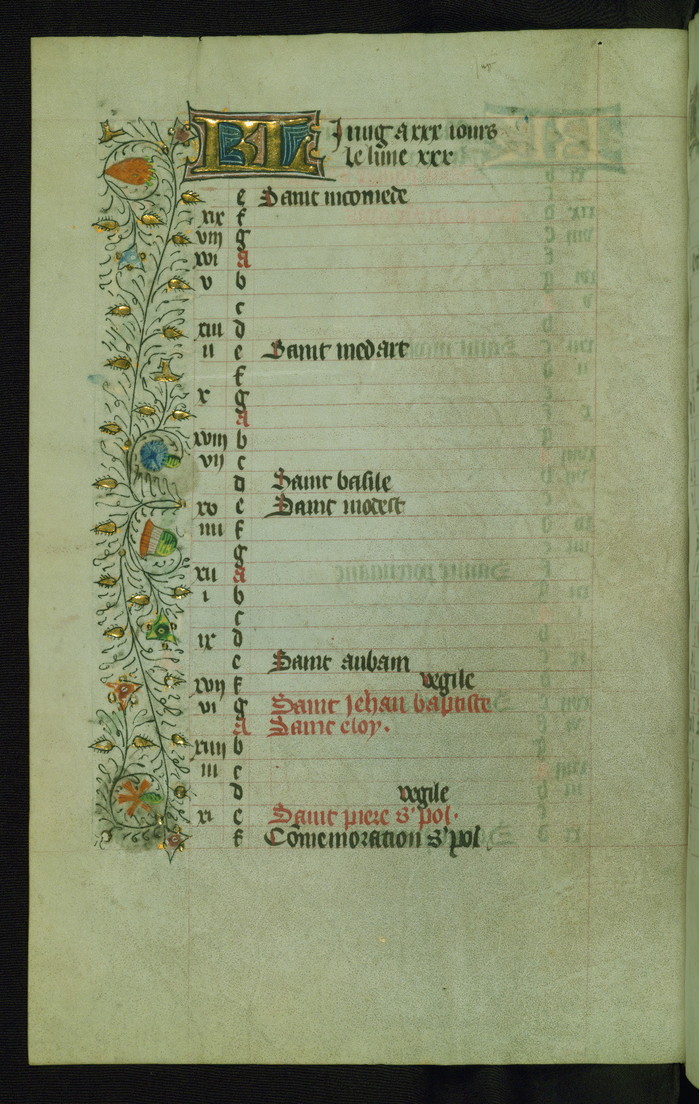
BPL MS q.med 131 (not available in their online catalogue), is a tiny (largest dimension is <4"), early (1320-1330) book of hours, Fransiscan Use, from Camerino, Italy. Despite the small size, the calendar is clear and readable where the ink is preserved. In addition to the feasts, there are notations of the signs of the zodiac in the calendar along with some liturgical notations, for example the earliest and latest dates for easter, and even the equinoctes and solstii. For an early calendar, the date range is unusually narrow due to notation in a later second hand, which has added some saints through the yeat, of the date 1338 at the end of April (see f.4v below). The 190 saints are irregularly spaced through the year, for example none in April before the 14th(see f.4r below), and the calendar is imperfect, there is no line for the 18 Kalends of October (Sept. 14).
(DB ID: 147)
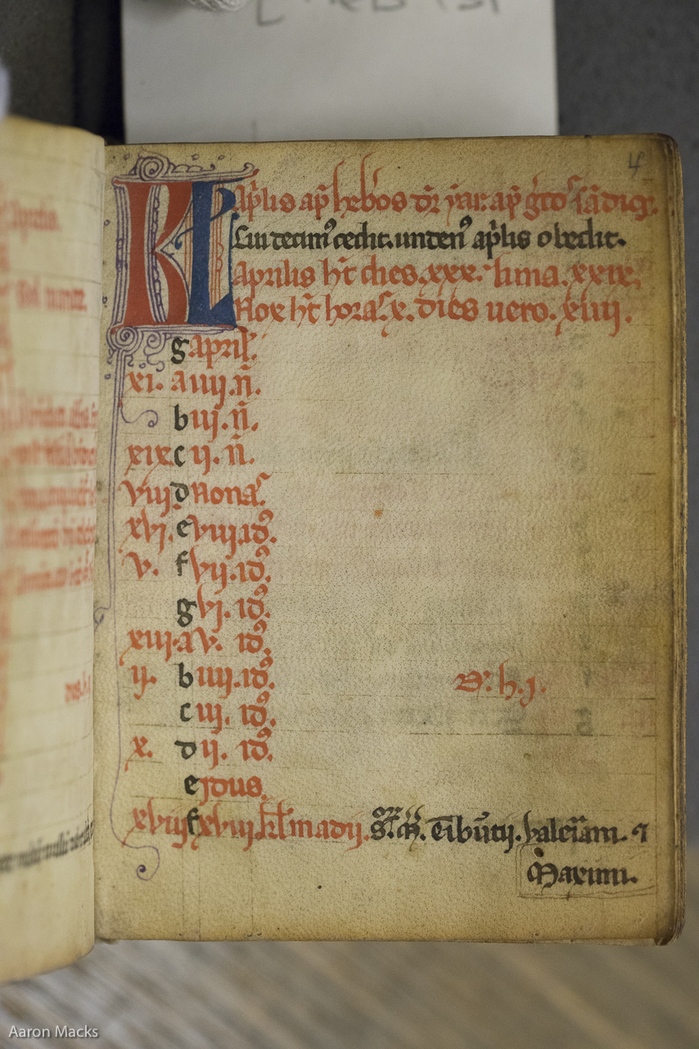
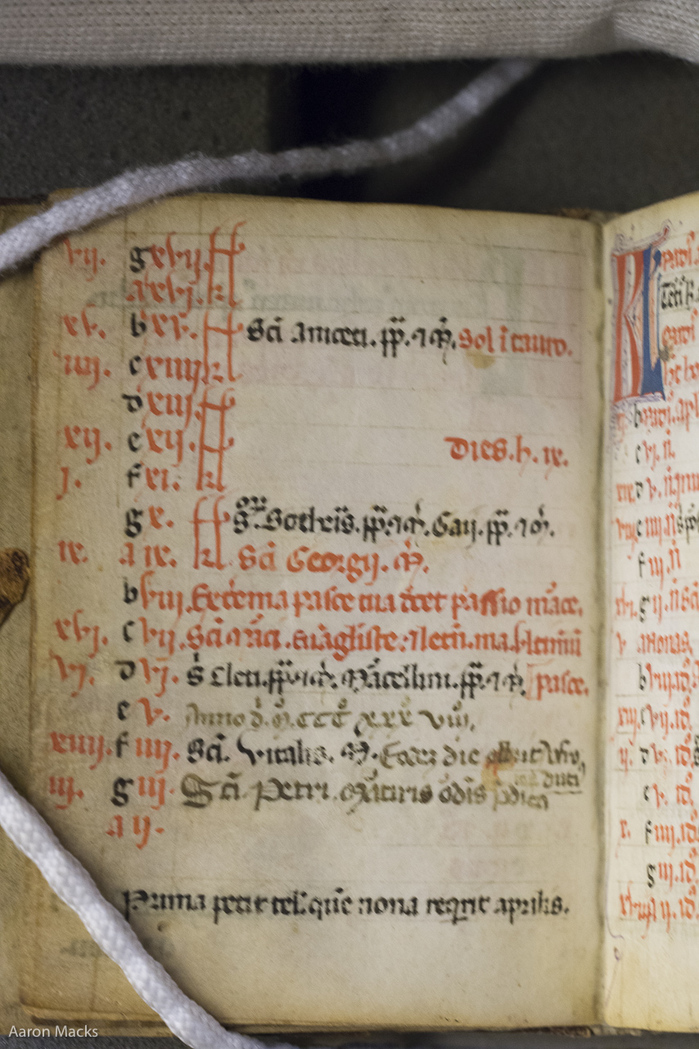
At first blush Harvard's Houghton Library ms Lat 132 is a somewhat unremarkable Use of Rome Hours from Bruges. Though it has 12 lovely miniatures in the style of the "Gold Scrolls group", the calendar is rather boring, red and black with red strikethroughs for medium-importance days like vigils. It was updated at least 2 seperate times, with a second hand writing in black Gothic similar to the original and a third hand in a later batarde . Hidden in it, however, is an interesting clue to the literacy of its owners, October 9th(see f.Fv below). Written in red, this is the Feast of St. Denis, patron of the eponymous cathedral just north of Paris and the martyr for whom Montmartre is named. Denis is a adaptation of his actual Greek/Latin name, Dionysus. The first scribe wrote Dyonisi Epi (Dionysus Bishop), as expected for a calendar in Latin, but the second scribe appended "S. Denis", either not understanding that they are the same, or for a patron who might not know the Latin.
(Link to the DB: 135)
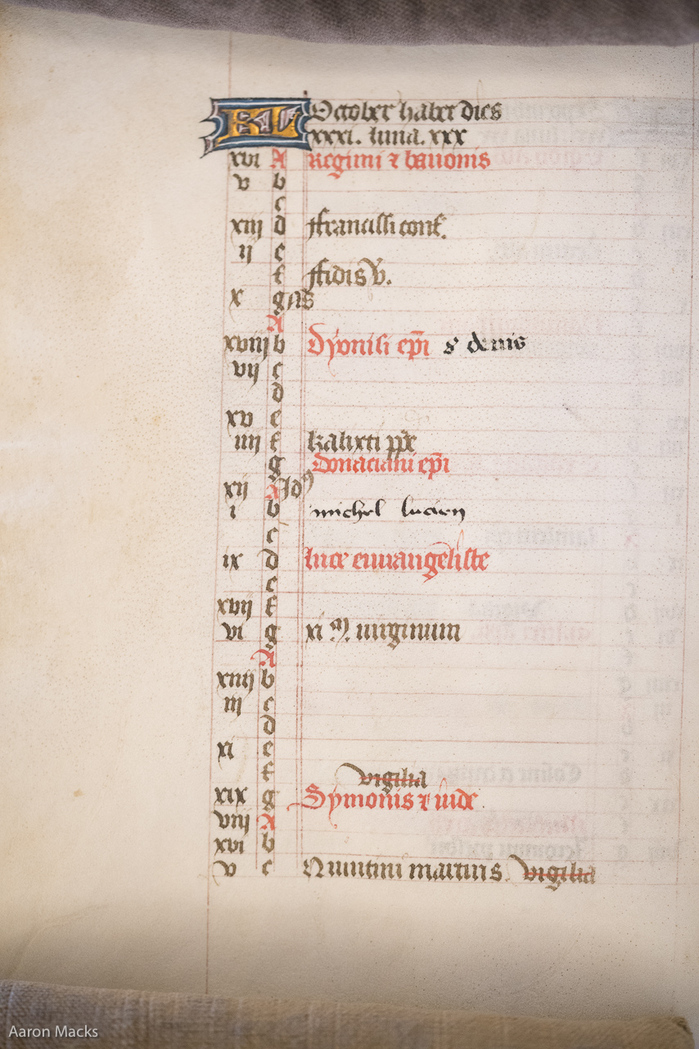
Bibliothèque nationale de France Nouvelle acquisition latine 3209 is another slightly odd, recently acquired Book of Hours. This one is Use of Rome, but calendar specific to Autun, and dated to right around 1450-1460. The calendar has several very specific-to-Autun entries, such as the “Revelation to St. Lazarus” on October 20(see in red f.5v below) and the “Dedication of the Church of St. Lazarus” on December 30th. The Cathedral of Autun is dedicated to St. Lazarus and has many of his relics, though in the early Middle Ages there was some confusion as to which Lazarus they had. This calendar is also somewhat unusual in calling out the Egyptian Days, which were thought to be especially inauspicious (see Oct 3 and 23). (See in the DB: 143)
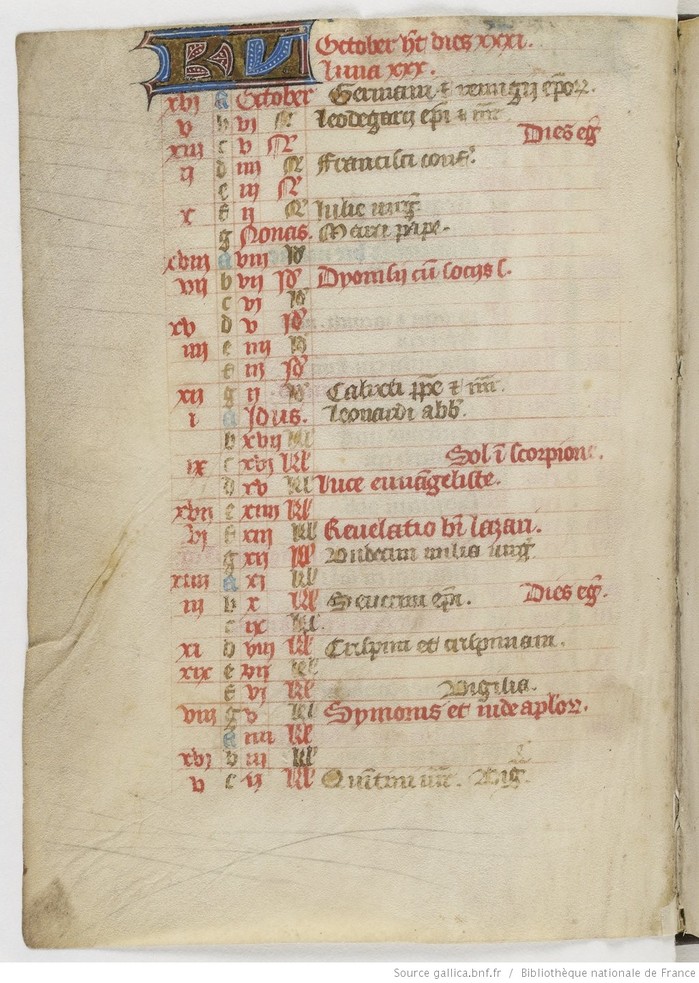
The Very Small Hours of Anne de Bretagne, Bibliothèque nationale de France Nouvelle acquisition latine 3120, is a fascinating tiny use of Rome book of hours from the last 15th Century. It was made in Paris and illuminated by Jean d'Ypres. The calendar is not complete, but very full, with 259 saints and 60 in gold. There are some interesting liturgical notes in the calendar, like the comment "Ultimu[m] Pascha" (the last possible day for Easter) April 24th (f.5v below). Note that it is right-justified with line-filler on the left. This is common throughout the calendar for liturgical notes, Vigils and Zodiac indications. (See in the DB: 142)
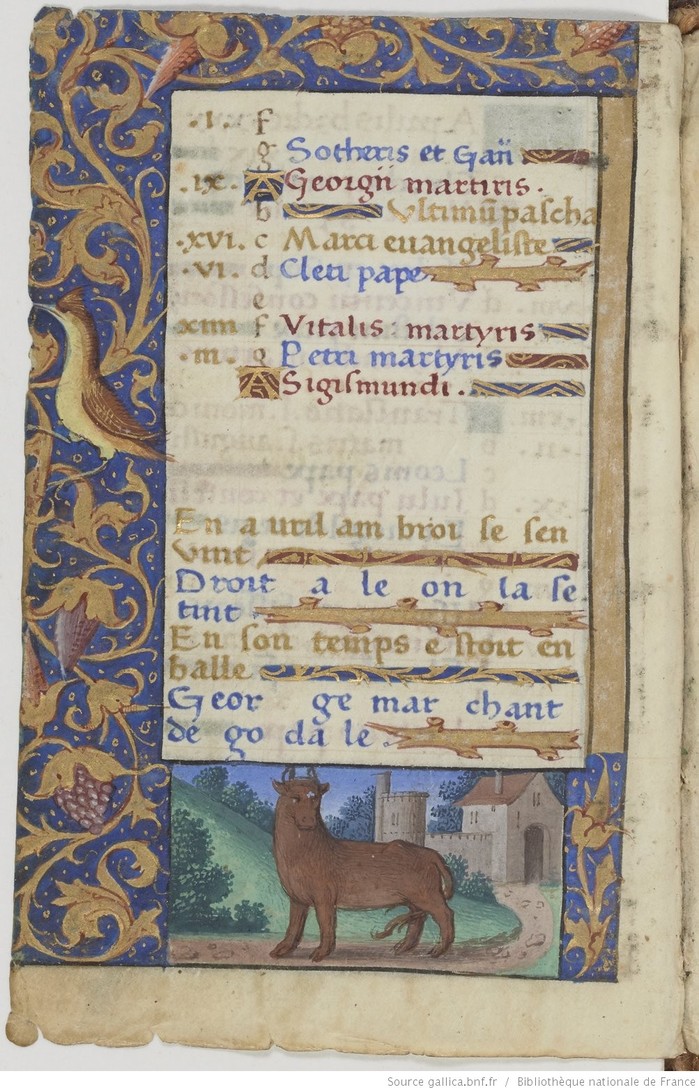
Harvard's Houghton Library MS Typ 553 is a weird Use of Rome Book from the late 15th century, only localized to "Northern Italy". The calendar is unevenly populated, 5 saints in March compared to 20 in January, and has a very large proportion of "high" importance (red) names, more even then normal rank saints. In addition to the usual saints, there are also most of the zodiac signs indicated as well as some here to for yet unidentified liturgical indications(see line 12 in May, f3r below). The scribal work is also unusual, there is no horizontal ruling at all, so the saints are often not alligned with the date information.
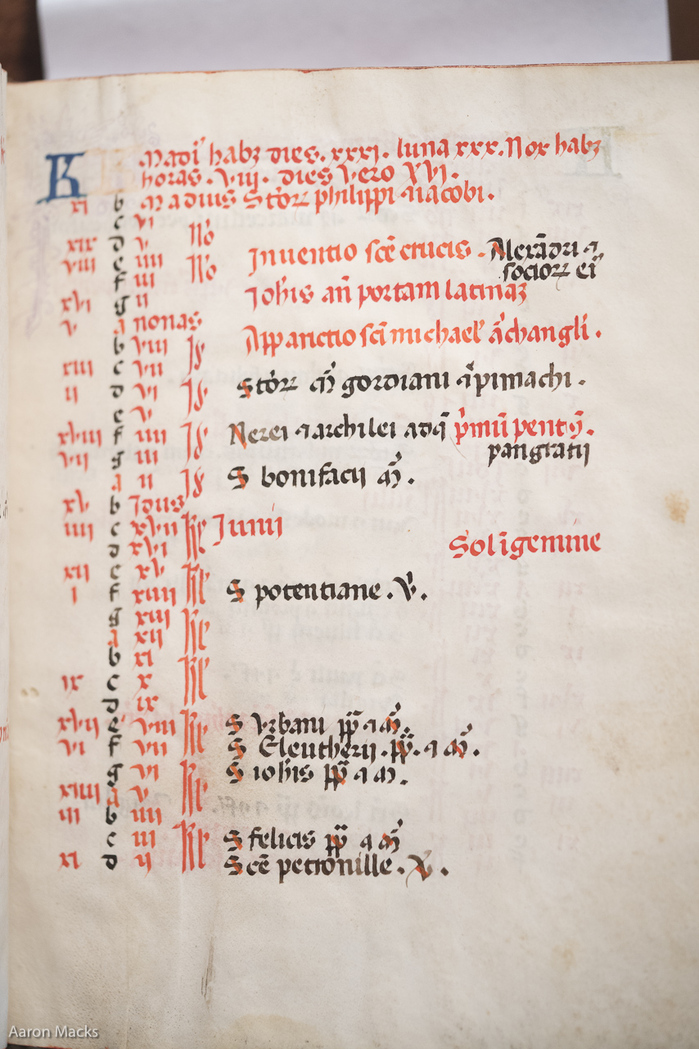
Bibliothèque nationale de France Nouvelle acquisition latine 3210, known as the Hours of Jean de Chateauneuf, is a Book from northern France made around the end of the 15th Century. It has a series of lovely miniatures, painted by Georges Trubert, tending towards shades of blue. The calendar is complete, unusual for a Use of Rome book, and again gives blue primacy, it is the color of the most important saints. The one flaw is that the blue ink is not as stable as the brown and red used for the rest of the entries and has faded to illegibility on some of the pages, see the first name on September (f.5r) below. There are also an unusually large number, 53, of unidentified saints. Further work is needed
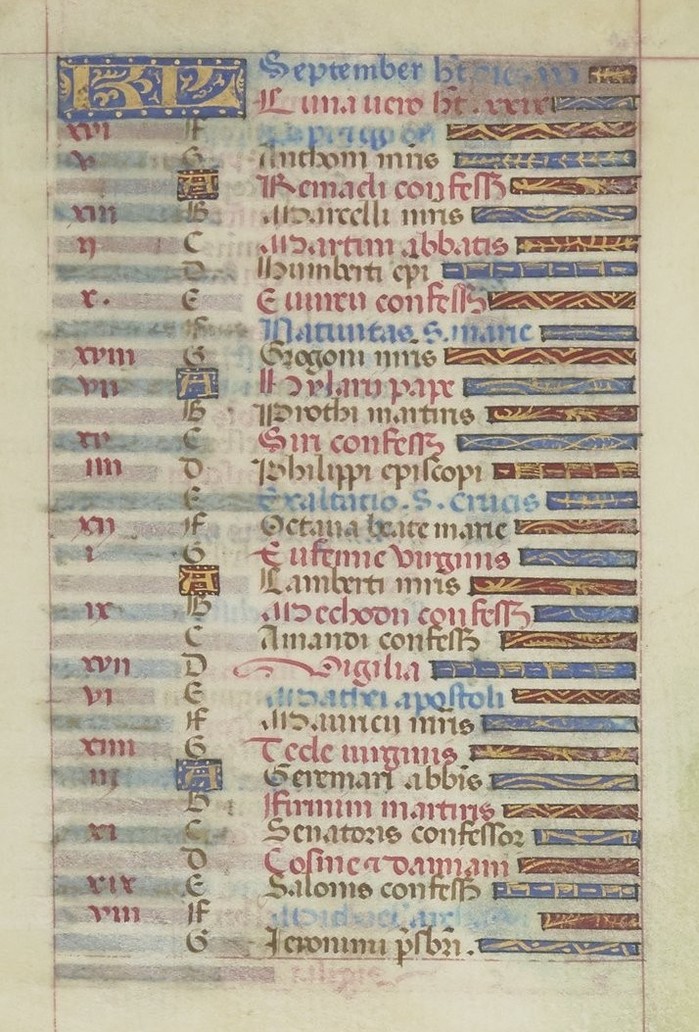
The first of three Books of Hours added during a visit to the BPL manuscript collection last week, MS q. med 137 is a beautiful small Book illumiated in the Workshop of Willian Vrelant, with text in a semi-batarde script. It's a somewhat unusual book liturgically, Use of Rome, but with calendar for Utrecht and text entirely in Latin. Most of the Utrecht books are the Dutch transtlation of Geert Groote. The Calendar itself has no very unusual details, there are only 160 entries and nearly all seem to match Bruges exemplars. The image below(f.28r) is after the calendar, the start of the Mass of the Blessed Virgin Mary, showing the gray and blue foliage that is common throughout the book
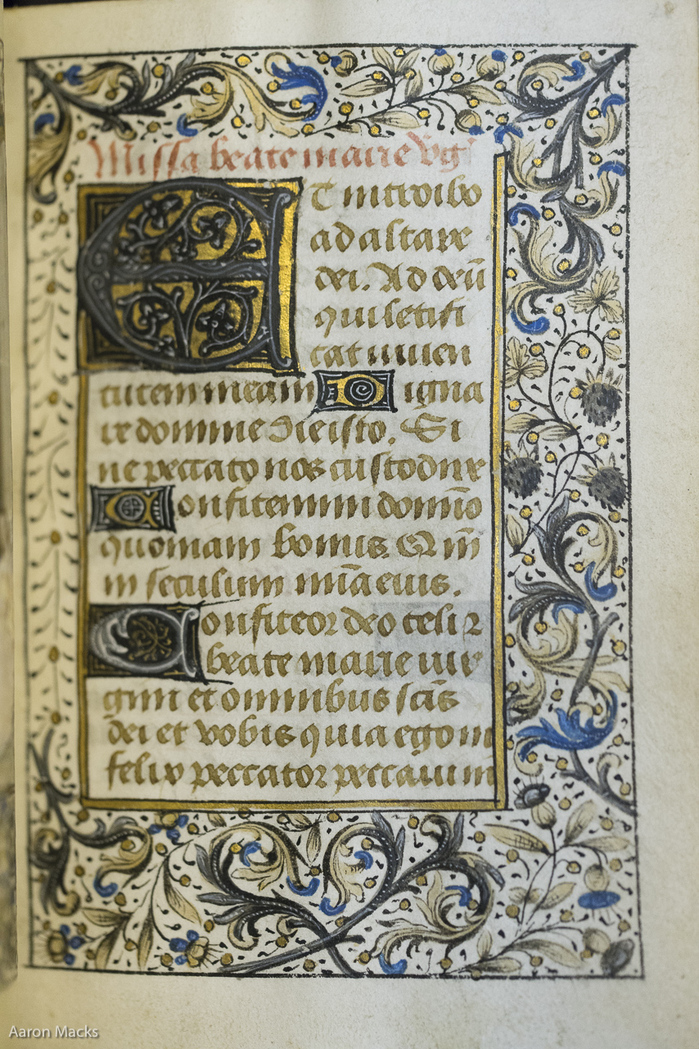
The Hours of Marguerite d'Orléans, Bibliothèque nationale de France MS Latin 1168b, is a lavishly illuminated Use of Rome book. The calendar has some unusual features including a pattern of red-red-blue-blue, in additional to the more common red-blue. The second page for March, f.3v, is a good example
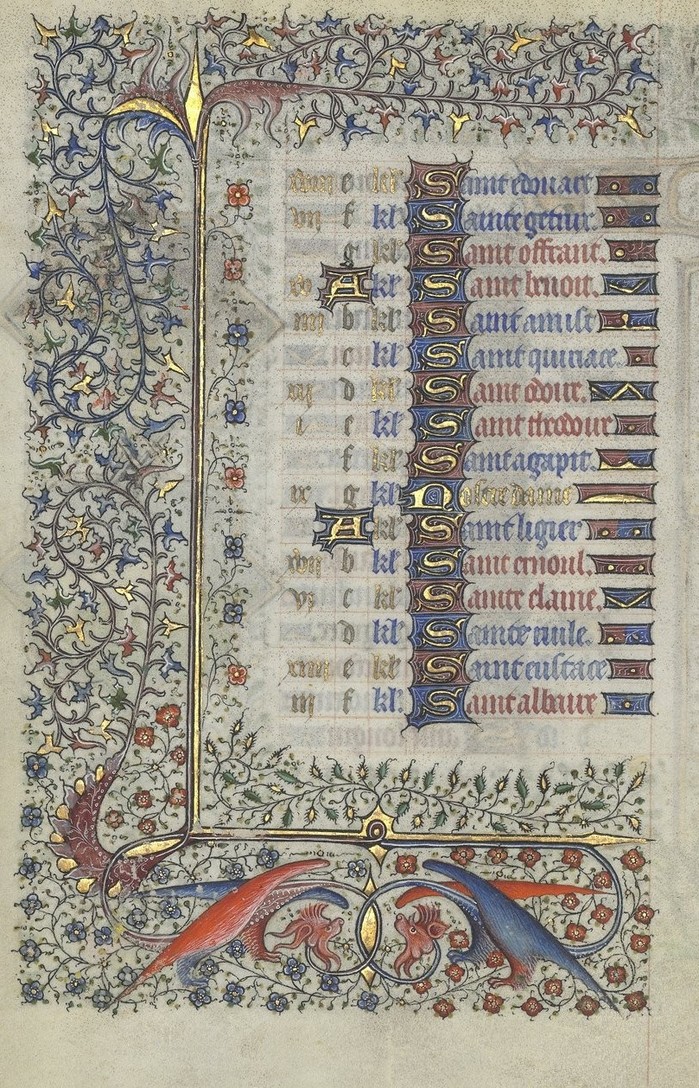
Thanks to the assistance of an indulgent librarian, I was able to finish the gorgeous, though fragmentary Houghton MS Typ 213, a Italian book from 1485-1494 written and illuminated by Bartolomeo Sanvito. The prayers are Use of Rome, but the calendar is localized to Padua. It's use of brown and gold ink made transcribing from photographs challenging, The first 1/2 of February, f.2r, is below
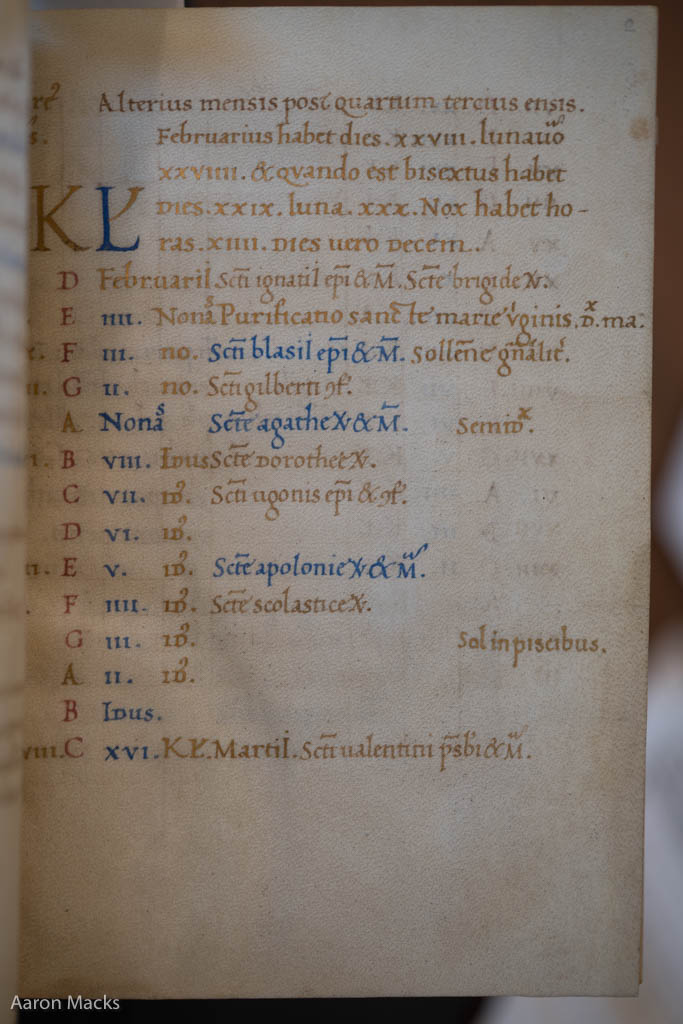
British Library Yates Thompson 29, known asthe 'Hours of Bonaparte Ghislieri', formerly known as 'The Albani Hours', is a lovely Humanistic Use of Rome book, from Bologna, about 1500. The calendar is decorated with the expected foliage and cameos, and the bottom of the first page of each month has an "important" saint, though not always one realated to the month. There's an interesting error in the months of May and June, may is incorrectly written with 30 days, ending with a dominical letter of 'c' (see f.5v below), which would have been right for May 30th. Either as an intentional correction or, more likely, as an error from the same cause, June has 31 days, and starts with dominical letter 'd'. The saint on the second line of June, however, is a correct saint for June 1, and the rest of the month continues in the same manner. There is no evidence for this practice, but if one were copying from a non-paginated calendar, this mistake would be easily possible
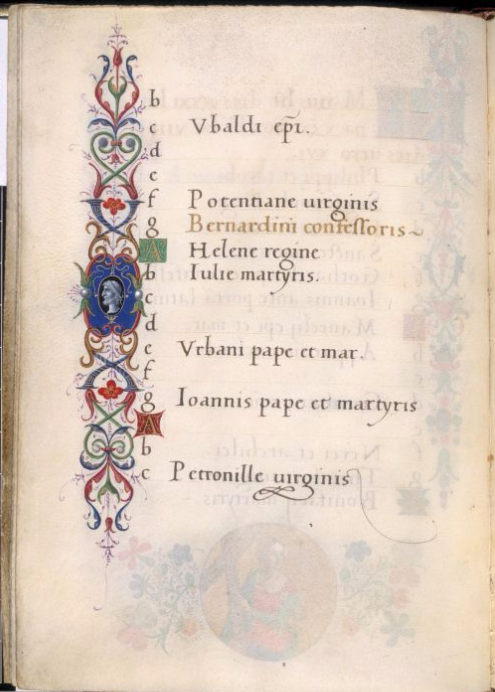
Latin 9474 from the Bibliothèque nationale de France is a spectacular late use of Rome book, known as the Grand Heures d'Anne de Bretagne. The entire program of illumination was done by Jean Bourdichon, student of Jehan Fouquet. Every month starts with the calendar overlaid over a scene of the labor, with the Zodiac sign in the sky as part of the scene. The verso has a border on the outer edge with realistic depictions of named flowers and insects. December is below (f.15r-v), with the slaughter of pigs under Capricorn.
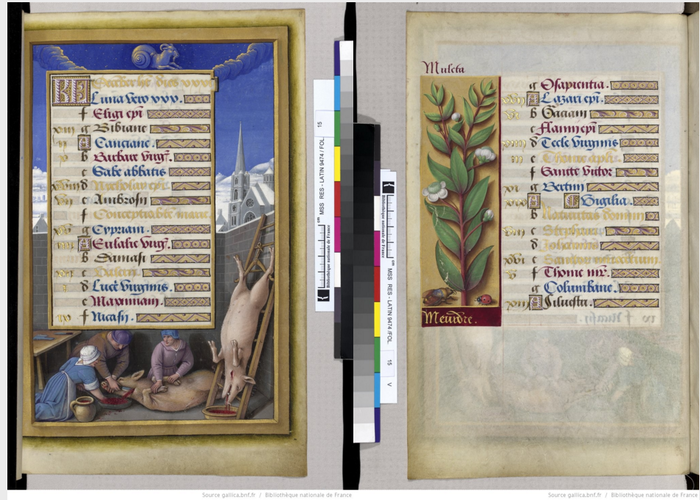
British Library Add MS 35313, known as the London Rothschild Hours, is another Flemish book of hours, this one probably made for a member of the Spanish court in the Netherlands. The complete calendar consists of only 6 folios, with one month per side. The decoration scheme is comprehensive, with the sign of the Zodiac at top, the labor of the month at bottom, and architectural roundels the full height of the outer edge representing the saints of the month. On the side of December, f.7r below, you can see the Nativity, the deaths of St. Thomas Becket and St. Stephen and a cephalophoric saint, among others. The calendar is interesting due to the large number of unusual saints, roughly 60, who were unmatched and their prevelance in March and April.
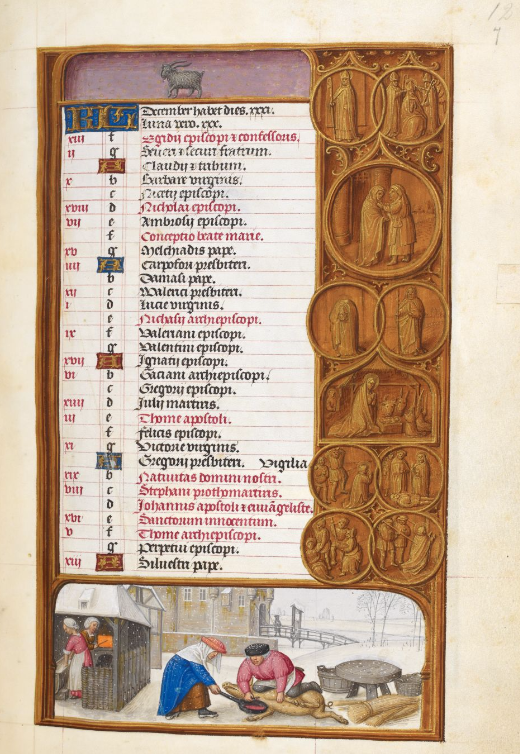
Another manuscript from the Richardson collection at Harvard's Houghton Library, Richardson 9 is a northern book, Use of Rome, from circa 1500, written in a very practiced Batarde hand. There are remarkably few errors in the completely-populated calendar and although it is not listed as such in the catalogues, the signs point to Bruges as the source of the calendar. The start of October (f.12v below) shows an interesting listing on the 3rd, Sts. Ewald and Ewald, 2 priests who died on the same day, are listed as "Duorum Enwaldorum", "The Two Enwalds"
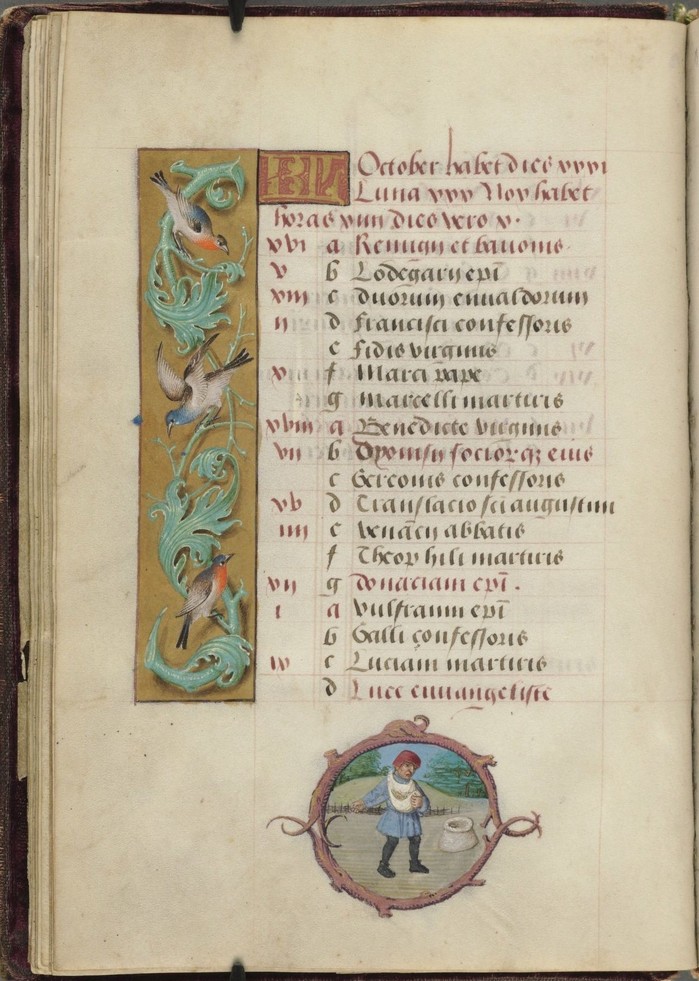
Harvard's Houghton Library MS Lat 251 is a turn-of-the 15th century Parisian book. Though the text is Use of Rome, the calendar is thoroughly Parisian. The text is fragmentary, with both text and illuminations missing, but the calendar is complete, with 260 entries. F.1r, below, is a good representitive of the decoration scheme, with banded foliage on the outer edge in muted colors. Also note the unusual missing entries for January 2-4, where the Octaves of Stephen, John and the Innocents would usually be.
